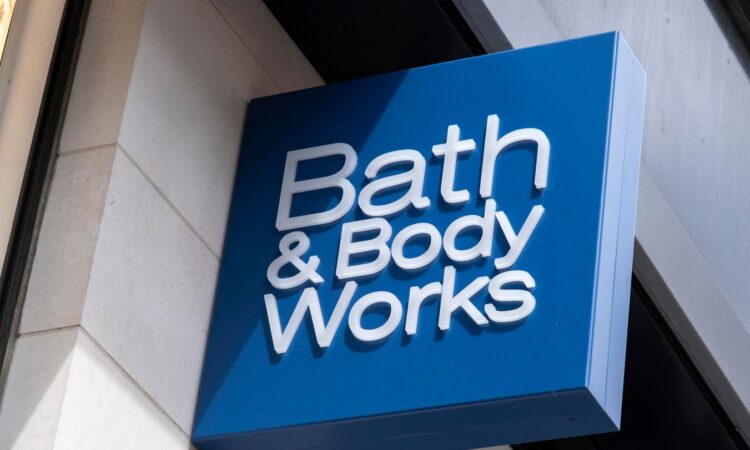
Sign for the brand Bath & Body Works on 9th July 2025 in London, United Kingdom. (photo by Mike Kemp/In Pictures via Getty Images)
In Pictures via Getty Images
Bath & Body Works stock (NYSE: BBWI) has decreased by 33% year to date, in contrast to a 13% increase in the S&P 500. What drives this sharp decline? A combination of waning consumer demand, pressure on margins, and investor fatigue. While the valuation of the company may seem appealing, that doesn’t guarantee stability.
On the surface, the stock appears inexpensive. BBWI is trading at merely 7.7 times earnings, 0.7 times sales, and 6.9 times free cash flow—significantly lower than the S&P 500 averages of 23.6x earnings, 3.2x sales, and 20.6x free cash flow. On paper, it appears to be a value buy. However, this doesn’t imply it will be shielded when the market faces challenges.
With markets hovering near all-time highs, numerous investors are inclined to view BBWI’s downturn as a chance to buy. But let’s take a moment to reflect—historically, the potential downside risk may be much greater than it currently seems. We elaborate on this further below.
Nevertheless, if you seek upward potential with reduced volatility compared to owning a solitary stock like BBWI, consider the High Quality Portfolio. It has notably outperformed its benchmark—a composite of the S&P 500, Russell, and S&P MidCap indexes—and has achieved returns exceeding 105% since its establishment. What contributes to this? Collectively, the HQ Portfolio stocks have offered superior returns with diminished risk compared to the benchmark index, avoiding significant fluctuations, as demonstrated in HQ Portfolio performance metrics. Additionally, take a look at –Buy AVGO Stock After 10% Drop?
The Fundamental Issue
BBWI might seem inexpensive, but just the price alone doesn’t ensure safety. Revenue has stagnated, with a decline of 1.8% on average over three years and only 0.2% over the last twelve months on $7.4 billion in sales—barely the momentum you desire. Margins are reasonable but facing pressure: 17.1% operating margin, 9.9% net, and 13.6% cash flow, indicating that even minor revenue declines can significantly affect earnings. And regarding the balance sheet? It’s thin. $5 billion in debt against a $5.4 billion market cap, with merely $364 million in cash. One decline in spending, and flexibility is lost.
Historical Context: The Pattern of Dramatic Declines
During the inflation shock in 2022, BBWI stock plummeted nearly 67% from its zenith while the S&P 500 only fell 25%. Even after a partial recovery, it has not returned to its previous highs. In the pandemic of 2020, BBWI decreased by 63%, albeit it quickly bounced back once stimulus measures boosted consumer spending. Furthermore, during the 2008 financial crisis, the stock fell by 79%, significantly worse than the market average, taking over two years to rebound.
This trend isn’t accidental. Bath & Body Works incessantly experiences disproportionate losses during every substantial downturn. It exemplifies a cyclical retailer that flourishes in prosperous times but collapses when consumer spending tightens.
The Risk Factors That Could Negatively Impact BBWI
- Growth Hurdles: With revenues significantly stagnant, the company lacks the top-line momentum necessary to withstand shocks or sustain growth.
- High Leverage: The debt levels are almost equivalent to the market capitalization, with limited cash reserves, providing little room for maneuver during a downturn.
- Margin Pressure: Operating and net margins are sufficient but not strong. Inflation, discounting, or weak demand could swiftly reduce profitability.
- Consumer Sensitivity: BBWI is heavily reliant on discretionary spending. Any dip in consumer confidence directly impacts the business.
- Market Sentiment: Retail stocks often face the sharpest declines when optimism diminishes, amplifying downside risk.
What’s the Actual Downside Risk?
At approximately $26 per share, BBWI may appear priced for vulnerability—but history suggests otherwise. In past downturns, the stock’s losses surpassed 60%. A similar decline would bring the shares closer to $10, emphasizing how susceptible the stock remains to changes in spending habits or market sentiment.
This is not an act of fearmongering; it’s a dose of realism. The stock has repeatedly demonstrated sensitivity to macroeconomic pressures. When growth slows or interest rates rise, BBWI doesn’t merely decline—it plummets.
The Alternative
The intent of this analysis is not to drive you away from BBWI. It aims to underscore the authentic downside risk. While such a scenario may or may not materialize, the likelihood is not negligible. You are not investing in a defensive business with stable cash flows; you are wagering on a consumer revival strong enough to counteract soft growth and high leverage.
If this level of risk makes you uncomfortable, you might want to explore the Trefis Reinforced Value (RV) Portfolio, which has exceeded its all-cap benchmark (a mixture of the S&P 500, S&P mid-cap, and Russell 2000 benchmark indices) to provide solid returns for investors. What contributes to this success? The rebalanced combination of large-, mid-, and small-cap RV Portfolio stocks offers a versatile strategy that capitalizes on favorable market conditions while controlling losses during market downturns, as detailed in RV Portfolio performance metrics.


